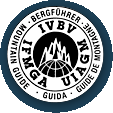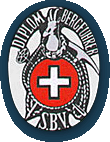|
|
Auf Deutsch |
|
Home |
or Guide Service Choosing a climb Info Contact Us


|
|
||||||||
|
|
Equipment List for Ski Mountaineering in the AlpsFor all mountaineering tours I highly recommend purchasing a Swiss Rescue membership from REGA to cover the costs in case of a rescue. The REGA membership is CHF 30.00 (covers Switzerland only) on the internet www.rega.ch for air rescue coverage during the tour. Please ensure you have the rescue coverage before starting any trip. Bring your Swiss or European Alpine club card so you can get the cheaper hut fee in the Swiss huts. I recommend consulting your travel agent for Swiss Rail, Euro Rail and any other train/rail pass for cheaper travel during your trip in the Alps. Some of the deals you can get on the market before leaving the USA give up to 50% discount on train and tram passes. It is worth taking some time and talking to your travel agent.

Swiss Guides does not cover any travel expenses before, after and during the tour! European Alps, Equipment List for Ski mountaineeringTechnical Gear:
Personal Gear:
Other items:
SWISS GUIDES L.L.C. ROCK-ICE-SNOWTraining plan for ski mountaineering in the AlpsStart intensive training at least 3 months prior to the planned ski mountaineering trip in Europe. The better your level of physical fitness is, the more enjoyable the ski trip and the experience will be. Running will not be enough, as uphill/downhill skiing uses different muscle groups in your body. Training must include some long, rigorous uphill skiing trips, walking or running. Being technically adept at ski mountaineering is as important as having a high level of physical fitness, so do not forget, Skiing/climbing Mountains is the best training. Adjust your gear and buy ski mountaineering boots far in advance, so everything will be properly worn in and adjusted to your feet and body. Acclimatization is also very important and the more time you spend over 13’000 ft., the faster you will be acclimatized in Europe. Last but not least, allow yourself a good break the week before the climb to be ready, but properly rested, for the climb. I recommend arriving at least 4 days prior to the meeting time and climbing trip so that you are over any jet lag that you might have. Medication:A lot of people take Diamox for the altitude. I recommend waiting until you are up around 12’000 ft. before taking any Diamox so that your body gets adjusted to the altitude and not to Diamox. Please contact your doctor and ask him/her for advice. Please feel free to contact me if you need any help or have any questions about training or equipment. Physical training planI understand every body works differently and some of you do not have much time to train ideally. The better shape you are in, the higher your success rate and fun you will have. We will ski/climb on an average day for 8 - 10 hr. with a small backpack. If you are extremely exhausted after 10 hrs. Of skiing/climbing, and should there be an emergency, you will not have the needed reserve and strength to continue safely. Therefore, being optimally fit is of the utmost importance. We will be ski/climbing on an average of 3’000 to 4’500 ft uphill a day. Average coverage is about 2 miles a hr. and 1’000 ft. uphill in an hour. The following is my recommended physical training plan:
I recommend skiing/climbing for 1hr. and taking a rest for max. 10 min. and every 4-6 hr, take a long break for max. ˝ hr. Train your body to climb on skins 1 hr. without stopping, it takes some discipline but the outcomes are great.
This training plan means at least 3 - 4 days a week of training. If you try to do this for 3 months, you will be incredibly fit and ready for the Alps. Do not forget that one-week prior to the trip, stop strenuous hikes for a total recovery. Technical training plan
Take classes with a certified American Mountain Guide if you need to work on basic mountaineering-, uphill skiing technique-, crevasse rescue - skills. For skiing skills contact a certified ski instructor. Hydration/DehydrationThis is a very important subject. We will ski /climb for 8-12 hr. and need to stay hydrated, but we can not carry more than 2 liters of water. Well, it is all training!!! The night before the activity drink lots of water and at breakfast time drink more water for a total of at least 2 liters of water. During the trip you will only drink little sips every other hour, so you still have some for the last stop. Camel bags do not work well because you do not have control of how much you will have left. Oftentimes, the Camel bags leak and freeze up in cold conditions. Therefore, they are not recommended. Rather, bring two 1- liter plastic bottles of water or one thermos bottle so you have some hot tea in the morning. If you do use a camel bag, bring at least one extra 1-liter water bottle. Your body can only handle so much water. If the body has too much water, it will take an excess amount of energy to separate the water and minerals as you hike and your energy level will come down. We are talking of a different approach to drinking on a climb than you are used to. Be open and try it, because this way you sweat less and you have to urinate less so you can concentrate on the climb. Remember we are not in a desert or in Alaska on 20;000 ft. After the climb you have to drink a lot of water to give your body back what it needs. Remember when you eat, food also has water in it and will help to hydrate as well. For the ski/climb, add Gatorade, juice or tea to your water because water by itself is not good enough. Train your body as suggested and not for a drinking festival. It is a clear sign of poor physical fitness if you have to drink every half hour and after 2-3 hours of hiking you are dehydrated. The problem lays in your physical fitness and not that you are necessarily hydrated. So keep training!!! We guarantee an IFMGA certified mountain guide for all activities.
My Swiss Guiding PhilosophyAs a professional guide it is my obligation to inform each and every one of my guests about my philosophy. I offer the experience of the journey as well as the flavor of the Swiss culture and not just the peak. My experience in guiding goes back some time, and I find it best to do a preparation climb for more difficult climbs. This allows us to get to know each other, and it gives me a chance to assess each client’s climbing skill level. It gives me time to help you improve your skills, adapt your pace and assist you in getting used to the short roping style we use in Europe. It also guarantees you a higher success rate on climbing the mountain of your dreams. Once we have done our warm up climb, I will let you know if you can do a harder climb or if we need to adjust the goal to a less demanding climb. If I determine while on a climb that a client is technically or physically not capable of completing the climb, for their safety and well being, I will cancel that particular climb for which they contracted and offer one that is appropriate to their skill level. Although we may be totally prepared for a climb, weather or mountain conditions may be the reason I choose to cancel the tour and offer an alternative climb or cultural tour. A note on being well within your physical and technical abilities on any given climb: unlike many other sports whereby people try to challenge themselves technically and to the edge of exhaustion, these are not safe options in mountaineering. If we are far from any hut or shelter when you reach your exhaustion level, simply stopping is not possible. In fact it may be that we have to go on for hours before reaching safety. We can have a little play room with the conditions and weather to a certain point, but physical and technical skills should not be tested in a mountain setting. We can do so in a safer environment such as short routes. To tackle a big mountain, one should have had experience on many similar climbs of that grade or harder. This ensures safety on the mountain! Mountaineers should not need any encouragement to go on while on a climb. As mountaineers we do not conquer peaks, we do it for ourselves to accomplish something, to stand in awe at the beauty of the mountains and to stay fit and give meaning to life. I believe all mountain guides should be certified through nationally and internationally recognized mountain guide associations such as the UIAGM/IFMGA. A certified guide is trained in the latest guiding and rescue techniques and has to go through a rigorous certification process. When a client entrusts their life to me, I consider this is a grave responsibility, one that drives my decision-making on a climb. This trust has manifested itself into close relationships with my clients, who have kept in contact with me throughout the years. I believe in no "great or the best guides". The only "good" guide is the one who makes it to old age! It is impossible to mountaineer totally risk-free, but without limiting risks, we do not accomplish anything we want get old enough to tell the story. Look at Reinhold Messner, for example, he is known as very safe climber and for always trying to avoid taking risks!
We like happy and returning clients!
Freddy Grossniklaus We guarantee an IFMGA certified mountain guide for all activities. |
|
||||||
|
|
||
|
|
Home
About
Ski
Mountaineering
Avalanche
Glacier
Rock
Prices
Choose
Registration
Contact
Hiking
Climb
©2021, Swiss Guides LLC info@swissrockguides.com |
|


